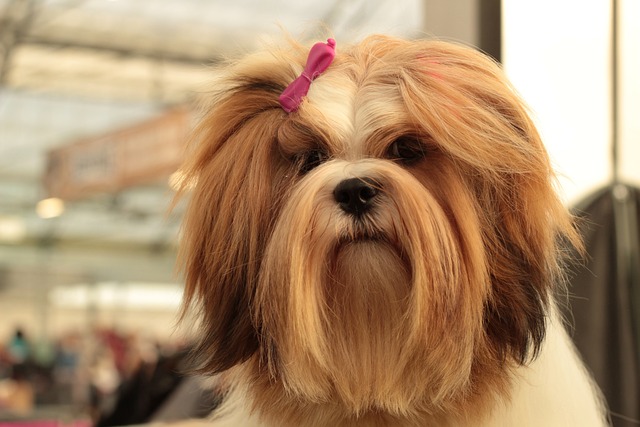


The Lhasa Apso is a small, sturdy, and affectionate dog breed that originated in Tibet. Known for its long, flowing coat and distinctive appearance, the Lhasa Apso was originally bred as a guard dog for Tibetan monasteries. Despite their small size, they have a bold, confident personality and are known to be very loyal and devoted to their families. The Lhasa Apso is also well-regarded for its alertness, making it a great watchdog. They are a wonderful companion dog for those who have the time to devote to their grooming and care needs.
The Lhasa Apso has a long and fascinating history that dates back over a thousand years. The breed was developed in the mountains of Tibet, where it was used by Tibetan monks and nobility as a sentinel dog for Buddhist monasteries. The Lhasa Apso’s primary role was to guard the monasteries and homes of the aristocracy, and they were known for their keen sense of hearing, which made them excellent watchdogs. The name "Lhasa" refers to the capital city of Tibet, and "Apso" is a Tibetan word meaning "long-haired dog." While the breed was highly regarded in Tibet, it was kept relatively rare, with strict regulations governing the breeding and export of the dogs. It wasn’t until the early 20th century that the Lhasa Apso was introduced to the Western world, where it quickly gained popularity as a companion animal.
The Lhasa Apso is a small dog, typically standing between 10 to 11 inches (25 to 28 cm) at the shoulder and weighing between 12 to 18 pounds (5.4 to 8.2 kg). The breed has a long, flowing coat that covers its entire body, giving it a distinctive appearance. The coat comes in various colors, including gold, cream, black, white, and a mix of these colors. The breed has a strong, sturdy frame with a square-shaped build and a well-feathered tail that curls over its back. Its head is proportionate to the body with a broad skull, dark eyes that give it a sweet and alert expression, and a distinctive beard and mustache. The Lhasa Apso’s coat requires regular grooming to prevent matting, making it a high-maintenance breed when it comes to personal care.
The Lhasa Apso is known for its charming and independent personality. While they are loyal to their families and can be very affectionate, they are also quite independent and sometimes aloof with strangers. This breed is alert, intelligent, and often proud, with a strong sense of territoriality. They are excellent watchdogs, always aware of their surroundings and quick to alert their owners to anything unusual. Despite their small size, Lhasa Apsos are confident and brave, often acting like much larger dogs. They can be playful and enjoy spending time with their family, but they are also content to be independent and sometimes prefer to relax in their own space. Early socialization and proper training are important to help the Lhasa Apso become a well-mannered companion.
The Lhasa Apso is a relatively low-energy dog that enjoys moderate exercise. They do not require extensive physical activity like some larger breeds but still need daily walks and playtime to stay healthy and mentally stimulated. Due to their small size, they are well-suited to apartment living or homes with limited space, provided they are given enough daily exercise. Lhasa Apsos also enjoy spending time with their owners, and interactive play can help keep them entertained. However, it’s important not to over-exercise the Lhasa Apso, as they are not as suited to long runs or strenuous activities as some other breeds. Mental stimulation is equally important, so puzzle toys, scent games, and training sessions are great ways to engage their minds.
The Lhasa Apso is an intelligent breed but can sometimes be stubborn, which may make training a bit of a challenge. They are independent dogs with a strong will, so it is important for owners to establish consistent and firm leadership from an early age. Positive reinforcement techniques, such as treats and praise, work best with this breed. Early socialization is crucial to ensure that the Lhasa Apso is comfortable around other animals and people. Without proper socialization, the Lhasa Apso may develop territorial behaviors or become overly aloof with strangers. They can learn commands and tricks fairly well, but patience and persistence are key when training a Lhasa Apso.
The Lhasa Apso is generally a healthy breed, but, like all dogs, they can be prone to certain health issues. Some common health concerns for this breed include hip dysplasia, patellar luxation (dislocated kneecap), and eye problems such as cataracts or progressive retinal atrophy (PRA). Regular veterinary check-ups are essential to maintain their health and address any potential issues early. The breed’s long coat requires regular grooming to prevent matting and tangles. Many owners choose to have their Lhasa Apso’s coat trimmed short to make grooming easier, though those who keep the coat long will need to brush it several times a week. Routine ear cleaning and dental care are also important aspects of maintaining a Lhasa Apso’s health.
The average lifespan of a Lhasa Apso is between 12 and 15 years. With proper care, including regular exercise, a healthy diet, and routine veterinary visits, they can live a long and fulfilling life. Like many small dog breeds, the Lhasa Apso can be prone to obesity, so it’s important to monitor their weight and provide a balanced diet. Regular physical exams, vaccinations, and dental care are essential for keeping them in good health throughout their lives.
© copyright Dog Compendium 2024 - 2025